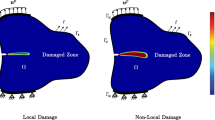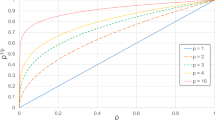Abstract
The solution of stress-constrained topology optimization problems is strongly affected by the accuracy of the computed stresses on the boundary of the evolving structure. In this paper, we address stress-constrained topology optimization using an explicit and precise representation of the boundaries. The geometrical model is a spline-based topology that evolves following the level set method. Untrimming techniques are used to construct the topology from the implicit boundaries defined by the level set function. Subsequently, a mechanical model that replicates the geometrical model precisely is constructed by mesh refinement. The governing state equations are solved using Iso Geometric Analysis (IGA). This leads to accurate stress computations and smooth stress fields, which are critical for constraining the stresses in regions that exhibit high concentrations. Consistent analytical sensitivity analysis is formulated for the entire procedure. Utilizing the smooth IGA solution, the stress is limited in the domain as well as in precise computation points on the boundaries. The applicability of the proposed approach, as well as its relative advantages compared to density-based approaches is demonstrated on several benchmark cases of stress-constrained topology optimization.


























Similar content being viewed by others
References
Allaire G, Jouve F (2008) Minimum stress optimal design with the level set method. Eng Anal Boundary Elem 32(11):909–918
Allaire G, Jouve F, Toader A-M (2004) Structural optimization using sensitivity analysis and a level-set method. J Comput Phys 194(1):363–393
Allaire G, Dapogny C, Frey P (2011) Topology and geometry optimization of elastic structures by exact deformation of simplicial mesh. CR Math 349(17–18):999–1003
Allaire G, Dapogny C, Frey P (2014) Shape optimization with a level set based mesh evolution method. Comput Methods Appl Mech Eng 282:22–53
Amstutz S, Novotny AA (2010) Topological optimization of structures subject to von Mises stress constraints. Struct Multidisc Optim 41(3):407–420
Andreasen CS, Elingaard MO, Aage N (2020) Level set topology and shape optimization by density methods using cut elements with length scale control. Struct Multidisc Optim 1–23
Bendsøe MP (1989) Optimal shape design as a material distribution problem. Struct Optim 1(4):193–202
Bruggi M, Venini P (2008) A mixed FEM approach to stress-constrained topology optimization. Int J Numer Methods Eng 73(12):1693–1714
Burman E, Claus S, Hansbo P, Larson MG, Massing A (2015) CutFEM: discretizing geometry and partial differential equations. Int J Numer Methods Eng 104(7):472–501
Christiansen AN, Nobel-Jørgensen M, Aage N, Sigmund O, Bærentzen JA (2014) Topology optimization using an explicit interface representation. Struct Multidisc Optim 49(3):387–399
Christiansen AN, Bærentzen JA, Nobel-Jørgensen M, Aage N, Sigmund O (2015) Combined shape and topology optimization of 3D structures. Comput Graph 46:25–35
Cottrell JA, Hughes TJ, Bazilevs Y (2009) Isogeometric analysis: toward integration of CAD and FEA. Wiley, Chichester
da Silva GA, Beck AT, Sigmund O (2019) Stress-constrained topology optimization considering uniform manufacturing uncertainties. Comput Methods Appl Mech Eng 344:512–537
De Leon DM, Alexandersen J, Fonseca JS, Sigmund O (2015) Stress-constrained topology optimization for compliant mechanism design. Struct Multidisc Optim 52(5):929–943
de Troya MAS, Tortorelli DA (2018) Adaptive mesh refinement in stress-constrained topology optimization. Struct Multidisc Optim 58(6):2369–2386
Duysinx P, Bendsøe MP (1998) Topology optimization of continuum structures with local stress constraints. Int J Numer Methods Eng 43(8):1453–1478
Duysinx P, Sigmund O (1998) New developments in handling stress constraints in optimal material distribution. In: 7th AIAA/USAF/NASA/ISSMO symposium on multidisciplinary analysis and optimization, 4906
Duysinx P, Van Miegroet L, Jacobs T, Fleury C (2006) Generalized shape optimization using X-FEM and level set methods. In: IUTAM symposium on topological design optimization of structures, machines and materials, Springer, pp 23–32
Emmendoerfer H Jr, Fancello EA (2014) A level set approach for topology optimization with local stress constraints. Int J Numer Methods Eng 99(2):129–156
Fries T-P, Belytschko T (2010) The extended/generalized finite element method: an overview of the method and its applications. Int J Numer Methods Eng 84(3):253–304
Giraldo-Londoño O, Paulino GH (2020) A unified approach for topology optimization with local stress constraints considering various failure criteria: von Mises, Drucker-Prager, Tresca, Mohr-Coulomb, Bresler-Pister and Willam-Warnke. Proc R Soc A 476(2238):20190861
Guo X, Zhang WS, Wang MY, Wei P (2011) Stress-related topology optimization via level set approach. Comput Methods Appl Mech Eng 200(47–48):3439–3452
Holmberg E, Torstenfelt B, Klarbring A (2013) Stress constrained topology optimization. Struct Multidisc Optim 48(1):33–47
Hughes TJ, Cottrell JA, Bazilevs Y (2005) Isogeometric analysis: CAD, finite elements, NURBS, exact geometry and mesh refinement. Comput Methods Appl Mech Eng 194(39–41):4135–4195
Jenkins N, Maute K (2015) Level set topology optimization of stationary fluid-structure interaction problems. Struct Multidisc Optim 52(1):179–195
Kang P, Youn S-K (2016) Isogeometric topology optimization of shell structures using trimmed NURBS surfaces. Finite Elem Anal Des 120:18–40
Kim H-J, Seo Y-D, Youn S-K (2009) Isogeometric analysis for trimmed CAD surfaces. Comput Methods Appl Mech Eng 198(37–40):2982–2995
Kiyono C, Vatanabe SL, Silva E, Reddy J (2016) A new multi-p-norm formulation approach for stress-based topology optimization design. Compos Struct 156:10–19
Kreissl S, Maute K (2012) Level-set based fluid topology optimization using the extended finite element method. Struct Multidisc Optim 46(3):311–326
Kreissl S, Pingen G, Maute K (2011) An explicit level set approach for generalized shape optimization of fluids with the lattice Boltzmann method. Int J Numer Methods Fluids 65(5):496–519
Le C, Norato J, Bruns T, Ha C, Tortorelli D (2010) Stress-based topology optimization for continua. Struct Multidisc Optim 41(4):605–620
Massarwi F, van Sosin B, Elber G (2018) Untrimming: precise conversion of trimmed-surfaces to tensor-product surfaces. Comput Graph 70:80–91
Massarwi F, Antolin P, Elber G (2019) Volumetric untrimming: precise decomposition of trimmed trivariates into tensor products. Comput Aided Geom Des 71:1–15
Moës N, Dolbow J, Belytschko T (1999) A finite element method for crack growth without remeshing. Int J Numer Methods Eng 46(1):131–150
Nagy AP, Benson DJ (2015) On the numerical integration of trimmed isogeometric elements. Comput Methods Appl Mech Eng 284:165–185
Noël L, Duysinx P (2017) Shape optimization of microstructural designs subject to local stress constraints within an XFEM-level set framework. Struct Multidisc Optim 55(6):2323–2338
Oest J, Lund E (2017) Topology optimization with finite-life fatigue constraints. Struct Multidisc Optim 56(5):1045–1059
París J, Navarrina F, Colominas I, Casteleiro M (2010) Block aggregation of stress constraints in topology optimization of structures. Adv Eng Softw 41(3):433–441
Pereira JT, Fancello EA, Barcellos CS (2004) Topology optimization of continuum structures with material failure constraints. Struct Multidisc Optim 26(1–2):50–66
Polajnar M, Kosel F, Drazumeric R (2017) Structural optimization using global stress-deviation objective function via the level-set method. Struct Multidisc Optim 55(1):91–104
Schleupen A, Maute K, Ramm E (2000) Adaptive FE-procedures in shape optimization. Struct Multidisc Optim 19(4):282–302
Schmidt R, Wüchner R, Bletzinger K-U (2012) Isogeometric analysis of trimmed NURBS geometries. Comput Methods Appl Mech Eng 241:93–111
Scott MA, Simpson RN, Evans JA, Lipton S, Bordas SP, Hughes TJ, Sederberg TW (2013) Isogeometric boundary element analysis using unstructured T-splines. Comput Methods Appl Mech Eng 254:197–221
Seo Y-D, Kim H-J, Youn S-K (2010) Isogeometric topology optimization using trimmed spline surfaces. Comput Methods Appl Mech Eng 199(49–52):3270–3296
Sethian JA, Wiegmann A (2000) Structural boundary design via level set and immersed interface methods. J Comput Phys 163(2):489–528
Shakour E, Amir O (2021) Topology optimization with precise evolving boundaries based on IGA and untrimming techniques. Comput Methods Appl Mech Eng 374:113564
Sharma A, Maute K (2018) Stress-based topology optimization using spatial gradient stabilized XFEM. Struct Multidisc Optim 57(1):17–38
Svanberg K (1987) The method of moving asymptotes-a new method for structural optimization. Int J Numer Meth Eng 24(2):359–373
Svärd H (2015) Interior value extrapolation: a new method for stress evaluation during topology optimization. Struct Multidisc Optim 51(3):613–629
Toshniwal D, Speleers H, Hughes TJ (2017) Smooth cubic spline spaces on unstructured quadrilateral meshes with particular emphasis on extraordinary points: geometric design and isogeometric analysis considerations. Comput Methods Appl Mech Eng 327:411–458
van Dijk NP, Maute K, Langelaar M, Van Keulen F (2013) Level-set methods for structural topology optimization: a review. Struct Multidisc Optim 48(3):437–472
Van Miegroet L, Duysinx P (2007) Stress concentration minimization of 2D fillets using X-FEM and level set description. Struct Multidisc Optim 33(4–5):425–438
Verbart A, Langelaar M, Van Keulen F (2017) A unified aggregation and relaxation approach for stress-constrained topology optimization. Struct Multidisc Optim 55(2):663–679
Villanueva CH, Maute K (2014) Density and level set-XFEM schemes for topology optimization of 3-D structures. Comput Mech 54(1):133–150
Villanueva CH, Maute K (2017) CutFEM topology optimization of 3D laminar incompressible flow problems. Comput Methods Appl Mech Eng 320:444–473
Wang Y, Benson DJ (2016a) Geometrically constrained isogeometric parameterized level-set based topology optimization via trimmed elements. Front Mech Eng 11(4):328–343
Wang Y, Benson DJ (2016b) Isogeometric analysis for parameterized LSM-based structural topology optimization. Comput Mech 57(1):19–35
Wang MY, Wang X, Guo D (2003) A level set method for structural topology optimization. Comput Methods Appl Mech Eng 192(1–2):227–246
Zhang W, Jiang S, Liu C, Li D, Kang P, Youn S-K, Guo X (2020) Stress-related topology optimization of shell structures using IGA/TSA-based Moving Morphable Void (MMV) approach. Comput Methods Appl Mech Eng 366:113036
Zhou M, Rozvany G (1991) The COC algorithm, Part II: Topological, geometrical and generalized shape optimization. Comput Methods Appl Mech Eng 89(1–3):309–336
Author information
Authors and Affiliations
Corresponding author
Ethics declarations
Conflict of interest
The authors declare that they have no conflict of interest.
Replication of results
To reproduce the presented results, all parameter settings and implementation aspects have been described in detail in the paper. In addition, we sincerely welcome scientists or interested parties to contact us for further explanation.
Additional information
Responsible Editor: Christian Gogu
Publisher's Note
Springer Nature remains neutral with regard to jurisdictional claims in published maps and institutional affiliations.
Rights and permissions
About this article
Cite this article
Shakour, E., Amir, O. Stress-constrained topology optimization with precise and explicit geometric boundaries. Struct Multidisc Optim 65, 42 (2022). https://doi.org/10.1007/s00158-021-03115-7
Received:
Revised:
Accepted:
Published:
DOI: https://doi.org/10.1007/s00158-021-03115-7




